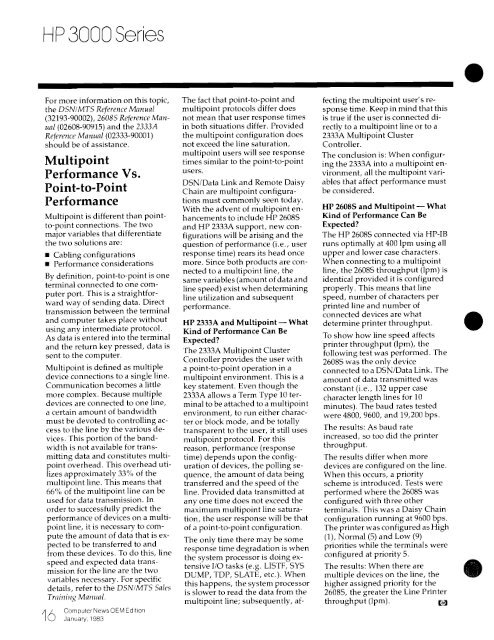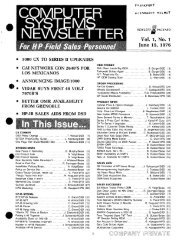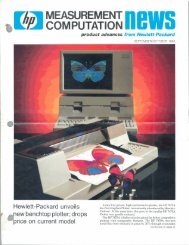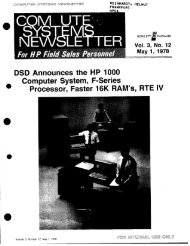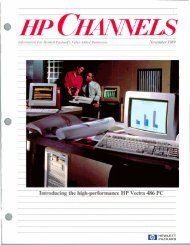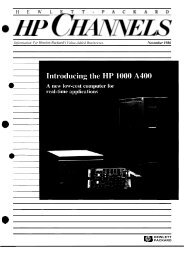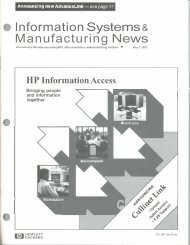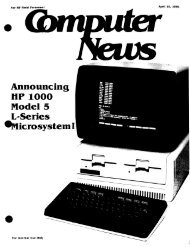edition - HP Computer Museum
edition - HP Computer Museum
edition - HP Computer Museum
You also want an ePaper? Increase the reach of your titles
YUMPU automatically turns print PDFs into web optimized ePapers that Google loves.
<strong>HP</strong> 3000 Series<br />
For more information on this topic,<br />
the DSNIMTS Reference Manual<br />
(32193-90002), 2608s Reference Manual<br />
(02608-90915) and the 2333A<br />
Reference Manual (02333-90001)<br />
should be of assistance.<br />
Multipoint<br />
Performance Vs.<br />
Point-to-Point<br />
Performance<br />
Multipoint is different than pointto-point<br />
connections. The two<br />
major variables that differentiate<br />
the two solutions are:<br />
Cabling configurations<br />
Performance considerations<br />
By definition, point-to-point is one<br />
terminal connected to one computer<br />
port. This is a straightforward<br />
way of sending data. Direct<br />
transmission between the terminal<br />
and computer takes place without<br />
using any intermediate protocol.<br />
As data is entered into the terminal<br />
and the return key pressed, data is<br />
sent to the computer.<br />
Multipoint is defined as multiple<br />
device connections to a single line.<br />
Communication becomes a little<br />
more complex. Because multiple<br />
devices are connected to one line,<br />
a certain amount of bandwidth<br />
must be devoted to controlling access<br />
to the line by the various devices.<br />
This portion of the bandwidth<br />
is not available for transmitting<br />
data and constitutes multipoint<br />
overhead. This overhead utilizes<br />
approximately 33% of the<br />
multipoint line. This means that<br />
66% of the multipoint line can be<br />
used for data transmission. In<br />
order to successfully predict the<br />
performance of devices on a multipoint<br />
line, it is necessary to compute<br />
the amount of data that is expected<br />
to be transferred to and<br />
from these devices. To do this, line<br />
speed and expected data transmission<br />
for the line are the two<br />
variables necessary. For specific<br />
details, refer to the DSNIMTS Sales<br />
Training Manual.<br />
1 6 January 1983<br />
<strong>Computer</strong> News OEM Edt~on<br />
The fact that point-to-point and<br />
multipoint protocols differ does<br />
not mean that user response times<br />
in both situations differ. Provided<br />
the multipoint configuration does<br />
not exceed the line saturation,<br />
multipoint users will see response<br />
times similar to the point-to-point<br />
users.<br />
DSNIData Link and Remote Daisy<br />
Chain are multipoint configurations<br />
must commonly seen today.<br />
With the advent of multipoint enhancements<br />
to include <strong>HP</strong> 2608s<br />
and <strong>HP</strong> 2333A support, new configurations<br />
will be arising and the<br />
question of performance (i.e., user<br />
response time) rears its head once<br />
more. Since both products are connected<br />
to a multipoint line, the<br />
same variables (amount of data and<br />
line speed) exist when determining<br />
line utilization and subsequent<br />
performance.<br />
<strong>HP</strong> 2333A and Multipoint - What<br />
Kind of Performance Can Be<br />
Expected<br />
The 2333A Multipoint Cluster<br />
Controller provides the user with<br />
a point-to-point operation in a<br />
multipoint environment. This is a<br />
key statement. Even though the<br />
2333A allows a Term Type 10 terminal<br />
to be attached to a multipoint<br />
environment, to run either character<br />
or block mode, and be totally<br />
transparent to the user, it still uses<br />
multipoint protocol. For this<br />
reason, performance (response<br />
time) depends upon the configuration<br />
of devices, the polling sequence,<br />
the amount of data being<br />
transferred and the speed of the<br />
line. Provided data transmitted at<br />
any one time does not exceed the<br />
maximum multipoint line saturation,<br />
the user response will be that<br />
of a point-to-point configuration.<br />
The only time there may be some<br />
response time degradation is when<br />
the system processor is doing extensive<br />
110 tasks (e.g. LISTF, SYS<br />
DUMP, TDP, SLATE, etc.). When<br />
this happens, the system processor<br />
is slower to read the data from the<br />
multipoint line; subsequently, af-<br />
fecting the multipoint user's response<br />
time. Keep in mind that this<br />
is true if the user is connected directly<br />
to a multipoint line or to a<br />
2333A Multipoint Cluster<br />
Controller.<br />
The conclusion is: When configuring<br />
the 2333A into a multipoint environment,<br />
all the multipoint variables<br />
that affect performance must<br />
be considered.<br />
<strong>HP</strong> 2608s and Multipoint - What<br />
Kind of Performance Can Be<br />
Expected<br />
The <strong>HP</strong> 2608s connected via <strong>HP</strong>-IB<br />
runs optimally at 400 lpm using all<br />
upper and lower case characters.<br />
When connecting to a multipoint<br />
line, the 2608s throughput (lpm) is<br />
identical provided it is configured<br />
properly. This means that line<br />
speed, number of characters per<br />
printed line and number of<br />
connected devices are what<br />
determine printer throughput.<br />
To show how line speed affects<br />
printer throughput (lpm), the<br />
following test was performed. The<br />
2608s was the only device<br />
connected to a DSNIData Link. The<br />
amount of data transmitted was<br />
constant (i.e., 132 upper case<br />
character length lines for 10<br />
minutes). The baud rates tested<br />
were 4800,9600, and 19,200 bps.<br />
The results: As baud rate<br />
increased, so too did the printer<br />
throughput.<br />
The results differ when more<br />
devices are configured on the line.<br />
When this occurs, a priority<br />
scheme is introduced. Tests were<br />
performed where the 2608s was<br />
configured with three other<br />
terminals. This was a Daisy Chain<br />
configuration running at 9600 bps.<br />
The printer was configured as High<br />
(I), Normal (5) and Low (9)<br />
priorities while the terminals were<br />
configured at priority 5.<br />
The results: When there are<br />
multiple devices on the line, the<br />
higher assigned priority for the<br />
2608S, the greater the Line Printer<br />
throughput (lpm).<br />
Pp3


